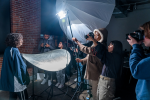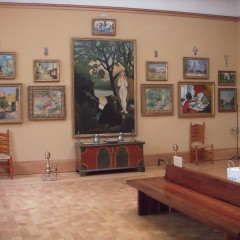Philadelphia has just gained another place to view great photography. The new Philadelphia Photo Arts Center (PPAC) at the Crane Arts Center is showing juried works by 21 young artists in the exhibit Next: Emerging Philadelphia Photographers.
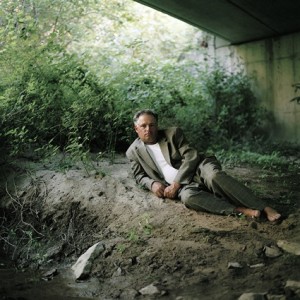
Most of these photos depict ambiguous, uncomfortable scenarios of a damaged world. Kyle Ferino’s Death of a Salesman depicts a dishevelled, shoeless man in a suit under an overpass, draped like a river god. The scenario is a kind of netherworld glade, hidden from respectable eyes. That hidden world, a disreputable Eden, made me think of Jeff Wall. There’s a mix of magic, threat and myth–the powerful scariness of someone who has become an outsider. Or maybe the subject is nothing more than a homeless guy in a safe corner.
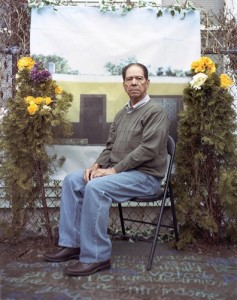
Xiomara Benavides’ Don Hilario is filled with questions. Was this a photoshoot portrait with backdrop in which the edges of the backdrop show to exhibit the artifice? And what about the chalked words on the ground? Is this crazy? Is he crazy? Are these his words? Yet Don Hilario looks so dignified, even in his jeans, sitting on a flimsy garden chair in a garden with a phony backdrop. Is the garden his? If not, whose? Whose backdrop is it, anyway? The image brings up all the early 20th Century immigrant photo portraits, with serious, dignified subjects posed in front of a pictorial backdrop. The color, the jeans, and the buildings peeking out from behind the backdrop are incontrovertible clues that this photo is not from a time past.
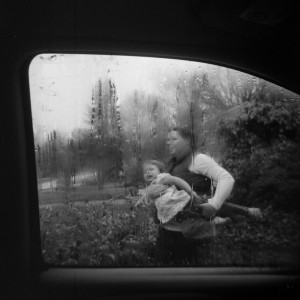
Snapshots may be the style of Felicia Perretti’s photos, but her on-the-fly photos are not exactly family vacations. Car Seat Fight, framed by a car window, shows a wailing child being roughly transported by a woman clearly irritated. It’s unclear who started the fight, and it’s unclear if the child is merely being moved or is about to catch hell on the side of the road. The view from inside the car suggests there’s a player in the scenario who is inside. The side of the road is a snatch of besmirched nature, a transitory world beyond the rules of orderly gardens and the home front. The photo becomes an emotionally fraught moral tale in which fairness and justice come under scrutiny.
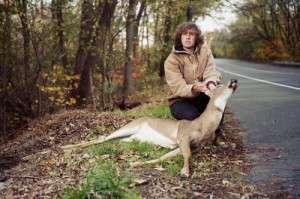
And speaking of roadside moral tales, Phil “Filthy” Jackson’s road kill photo with what I take to be a distraught Davis, may in fact be a hunter and his prey. Either way, Bambi is under threat from the human race. As in all these photos above, Eden is lost.
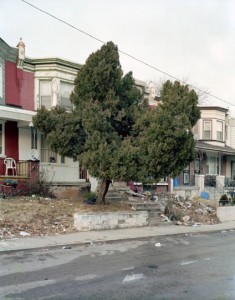
The Eden theme comes up in a couple of photos by Daniel Traub, but in Traub’s cause, Eden isn’t so much lost as aspired to. His Tree, North West Philadelphia 2008, is a scrappy survivor on a trash strewn rowhouse front lawn, nature’s toehold in an unwelcoming environment. Traub’s Two boys, North Philadelphia 2008, shows two slightly uncomfortable, vulnerable youths, one hiding behind his hoodie with his legs in a posturing wide stance, one with his hands clasped shyly in front and his legs close together, in front of a weedy array of growth. Their young good looks also suggest survival, as does the tree, and the weedy Eden behind them tells pretty much the same story. (Traub also has an exhibit up at the Art Institute of Philadelphia until Oct. 16).
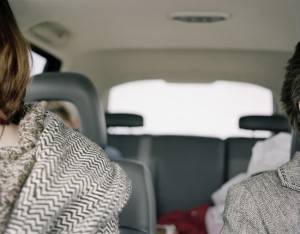
Formal issues also caught my eye–Sarah Moore’s surprising framing of shots–she splits a woman’s head in two in the diptych, Fall, which also is about textures of a scarf and the landscape–and a sort of Eden. Again using a surprising split to very different effect, Moore shoots the back window of a car in Anterior Future, putting the humans only partially in the picture, with their matching herringbone coats (are they friends or mother and daughter?). The suggestion of time past/road travelled, out the back window, colors the story of the two women and their related coats.
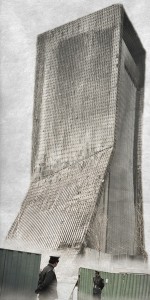
The rice paper surface of Matthew Thomas Cianfrani’s Contemplating charred hotel on cloudless day in Chaoyang District suggests China as much as the title does. The atmospheric photo, with its sense of disintegration and insubstantiality rings true to its message. The domineering form of the destroyed building is far from the gritty urban environments of the other cityscapes in this exhibit. The photo communicates its own sort of horror and regret.
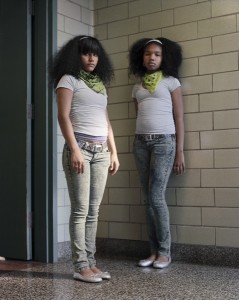
Some of the smaller photos in the show are given short shrift, hung too close together. But all in all, this is a terrific show and a great beginning. Others in the exhibit are Martin Buday, Christopher Gianunzio, Jaime Alvarez, Samantha Sheehan, Chad States, Tom Goodman, Danielle Bogenhagen, Gene Smirnov, Bob Myaing, Elyse Derosia, Hannah Price, DM Witman, Kelsey Johnson, and Joshua Lanzara. The exhibit was juried by Ariel Shanberg, executive director of the Center for Photography at Woodstock. Woodstock! …speaking of metaphors for Eden lost!
The exhibit is up to Nov. 29.


